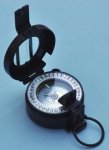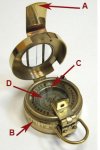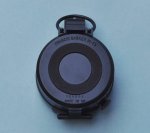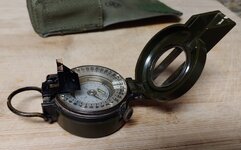dblust
FNG
In an earlier post titled “Choosing a Compass,” I talked about the three compasses I consider the best choices for the serious back country navigator. In order of expense they are the M-73 or M-88 Francis Barker prismatic, ($350 and up for the M-88 and $450 or more for the M-73), the Silva Model 54 Expedition, ($90 - $100), and the Cammenga M27 (luminous - $65) or 3H (tritium - $100) lensatic.
No one wants to spend more than necessary, and while bargains can be found on Internet auction sites such as eBay, caution must be exercised; it’s easy to inadvertently buy the wrong compass or, in some instances, be ripped off. I'm going to put up three posts on buying these compasses on the Internet - one each for the Francis Barker M-73 or M-88, Cammenga Lensatic, and Silva Expedition 54. (The reason for splitting them up is that I just found out only five images per post are allowed.)
Francis Barker M-73 / M-88
First, the genuine Francis Barker M-73 (at left below) and M-88 (at right below).


Real M-73s are painted black and M-88s are green. Virtually all the counterfeits I’ve encountered over the years have been unfinished, shiny brass, most of which were/are manufactured in the Middle East. (Which is not to say that genuine, gleaming brass Francis Barkers do not exist. A “presentation” model is available for around $650; aside from not being painted, it’s identical to the M-73.)
There are always cheap, counterfeit M-73 knockoffs on the Internet, but fortunately they are easy to spot; the one below is a good example. The features of a knockoff are as follows:

A - Where there is a sighting notch and a tritium lamp on a genuine Francis Barker’s cover/sighting tab, none exist on a counterfeit, as shown.
B - The compass bowls of counterfeits are often graduated with the 32 compass points, (North, North by East, North-Northeast, Northeast by North, Northeast, etc.), as shown. While much older, genuine British prismatic compasses are so marked, new ones are not.
C and D indicate locations where tritium lamps are located on genuine M-73s. None exist on counterfeits.
The positive identifying features of a genuine M-73 are the markings on its base, as shown below:

Recently a good many Model 88s (the lightweight version of the M-73s) have surfaced for sale on the Internet, mostly from British sources and often at very reasonable prices. These are genuine; that’s not the problem. The thing to bear in mind is that they’re military surplus and most likely to be graduated in mils rather than degrees. (While working with mils is readily accomplished, it requires doing a little math, as described in my last post, “Choosing a Compass.”) In addition, such M-88s are likely to be nearing or past 10 years old, in which case their tritium vials will be growing dim.
Vintage British prismatics from the World War II era can often be found on eBay and other auction sites. While often completely functional, they should be seen as collector’s pieces, not working compasses.
No one wants to spend more than necessary, and while bargains can be found on Internet auction sites such as eBay, caution must be exercised; it’s easy to inadvertently buy the wrong compass or, in some instances, be ripped off. I'm going to put up three posts on buying these compasses on the Internet - one each for the Francis Barker M-73 or M-88, Cammenga Lensatic, and Silva Expedition 54. (The reason for splitting them up is that I just found out only five images per post are allowed.)
Francis Barker M-73 / M-88
First, the genuine Francis Barker M-73 (at left below) and M-88 (at right below).


Real M-73s are painted black and M-88s are green. Virtually all the counterfeits I’ve encountered over the years have been unfinished, shiny brass, most of which were/are manufactured in the Middle East. (Which is not to say that genuine, gleaming brass Francis Barkers do not exist. A “presentation” model is available for around $650; aside from not being painted, it’s identical to the M-73.)
There are always cheap, counterfeit M-73 knockoffs on the Internet, but fortunately they are easy to spot; the one below is a good example. The features of a knockoff are as follows:

A - Where there is a sighting notch and a tritium lamp on a genuine Francis Barker’s cover/sighting tab, none exist on a counterfeit, as shown.
B - The compass bowls of counterfeits are often graduated with the 32 compass points, (North, North by East, North-Northeast, Northeast by North, Northeast, etc.), as shown. While much older, genuine British prismatic compasses are so marked, new ones are not.
C and D indicate locations where tritium lamps are located on genuine M-73s. None exist on counterfeits.
The positive identifying features of a genuine M-73 are the markings on its base, as shown below:

Recently a good many Model 88s (the lightweight version of the M-73s) have surfaced for sale on the Internet, mostly from British sources and often at very reasonable prices. These are genuine; that’s not the problem. The thing to bear in mind is that they’re military surplus and most likely to be graduated in mils rather than degrees. (While working with mils is readily accomplished, it requires doing a little math, as described in my last post, “Choosing a Compass.”) In addition, such M-88s are likely to be nearing or past 10 years old, in which case their tritium vials will be growing dim.
Vintage British prismatics from the World War II era can often be found on eBay and other auction sites. While often completely functional, they should be seen as collector’s pieces, not working compasses.


